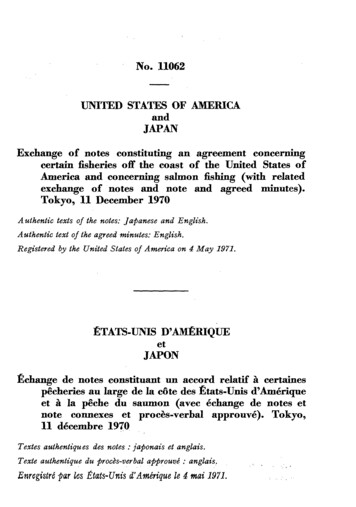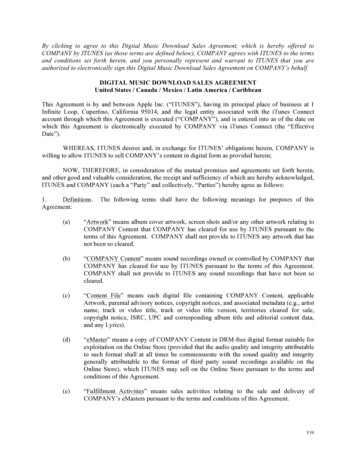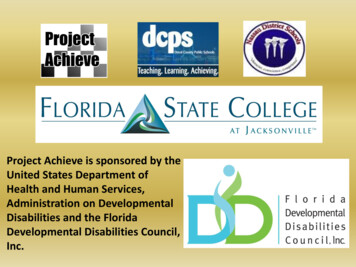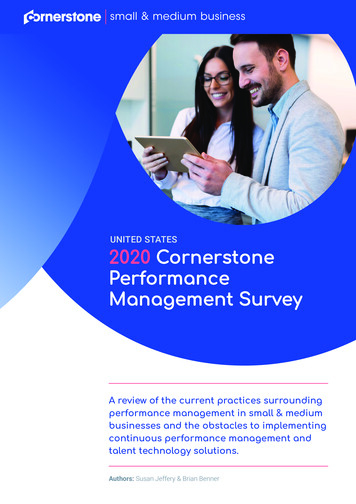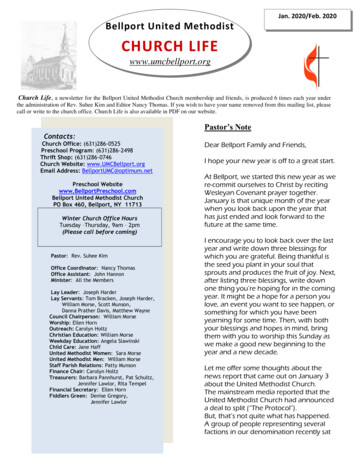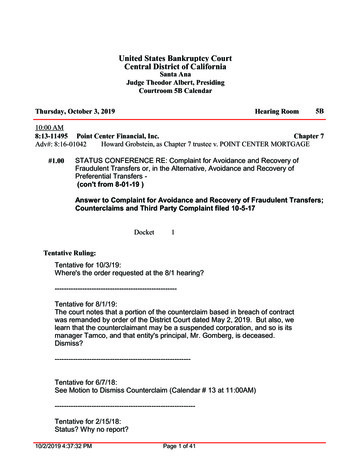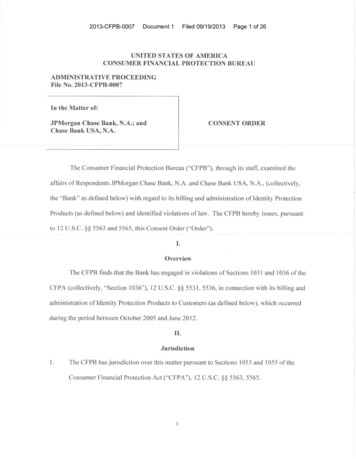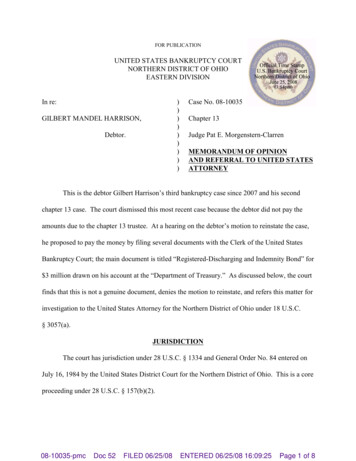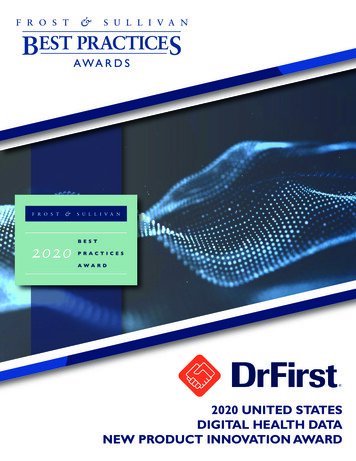
Transcription
2020 UNITED STATESDIGITAL HEALTH DATANEW PRODUCT INNOVATION AWARD
BEST PRACTICES RESEARCHContentsBackground and Company Performance . 3Industry Challenges. 3New Product Attributes and Customer Impact . 4Conclusion . 10Understanding New Product Innovation . 11Key Benchmarking Criteria . 11Best-Practices Award Analysis for DrFirst . 12Decision Support Scorecard . 12New Product Attributes . 13Customer Impact . 13Decision Support Matrix . 14Best-Practices Recognition: 10 Steps to Researching, Identifying, and Recognizing BestPractices . 15Research Methodology . 16About Frost & Sullivan . 16 Frost & Sullivan 20202“We Accelerate Growth”
BEST PRACTICES RESEARCHBackground and Company PerformanceIndustry ChallengesIn an era of increasing volumes of patient-related healthcare data, successfully managingpatients’ medication and clinical needs could be resolved with improved data flow, dataanalytics, and telehealth connectivity. Healthcare delivery is changing rapidly, primarilydriven by the need to protect all stakeholders from exposure to viruses and othercontagious diseases while delivering timely patient-centered care. During times of rapidevolution, precautions to ensure safe medical practices, patient privacy, and appropriatereimbursement must be taken. Medical errors can occur when “information is unrecorded,misdirected, never received, never retrieved, or ignored,” according to patient safetyexperts at CRICO Strategies. Four specific challenges that can be addressed by innovativedigital technology include care collaboration (including telehealth), medication and clinicalmanagement, medication reconciliation, and medication adherence.Medication management involves the proper use of prescribed drugs by patients. Thisservice supports the need for patients to take their medications at the appropriate timeand helps avoid potential interactions with other prescribed medicines. Many patientsmust remember to take several prescribed drugs per day. Those who take prescriptiondrugs take an average of four, and many also take over-the-counter medicines, vitamins, andother dietary supplements, according to a Consumer Reports survey. Patients can getoverwhelmed quickly by the volume of prescribed drugs that they consume and mayforget to tell their doctors all the medications they are taking.A prescriber’s lack of knowledge about the full array of drugs a patient takes could resultin a medical error. Unwitting medical errors are the most significant threat of poormedication management. According to a 2016 study, “ADEs [adverse drug events]account for more than 3.5 million physician office visits and 1 million emergencydepartment visits each year. It is believed that preventable medication errors impact morethan 7 million patients and cost almost 21 billion annually across all care settings.”1Providing doctors with a more robust, accurate, and precise medication history as well astechnology that improves medication matching can mitigate the risks of ADEs.Collaborating on and coordinating patient care across providers, clinical and medicationservices, patients, and other caregivers are proven to avoid ADEs, protect healthcareparticipants from unnecessary exposure to viral infections, and provide patients access totheir healthcare providers, regardless of care setting. Industry analysts cite the followinginformation based on Frost & Sullivan research: 81% of patients are more likely to select a medical provider who offerstelemedicine services over one who does not when choosing doctors. 2 Perceived barriers to adoption of telehealth included difficulties integrating it intothe practice workflow (mentioned by 42% of respondents), no patient access to theBrianna A. da Silva and Mahesh Krishnamurthy (2016), “The alarming reality of medication error: a patient case and review of Pennsylvaniaand National data,” Journal of Community Hospital Internal Medicine Perspectives 6:4, DOI: 10.3402/jchimp.v6.31758.2Lisa Hedges (2019), “Should You Offer Telemedicine Services? Patients Weigh In,” SoftwareAdvice.com.1 Frost & Sullivan 20203“We Accelerate Growth”
BEST PRACTICES RESEARCHtechnology (36%), concern about potential medical errors (29%), and security andprivacy of patient information (23%). 3 More than 70% of patients feel fully satisfied when they receive coordinated care. Approximately 20% of the patients switch providers every year due to a lack oftrust in their care teams. Close to 70% of patients prefer to make more informed clinical decisions related topayer and provider services when they have access to their accurate medical data. Medical errors during transitions of care are prevalent; 80% of clinical errors occurdue to the lack of coordinated communication during care transitions.4Medication adherence involves patients properly complying with a prescribed treatmentplan. According to a recent article, “Medication nonadherence for patients with chronicdiseases is extremely common, affecting as many as 40% to 50% of patients who areprescribed medications for the management of chronic conditions such as diabetes orhypertension. At least 100,000 preventable deaths and 100 billion in preventable medicalcosts per year are due to nonadherence to prescribed treatment.”5 Solutions that engagepatients and increase medication adherence from first fill through maintenance must notbe cumbersome and overbearing or overly intrusive.Collaboration and telehealth tools must be easy to implement for organizations; intuitiveto use for clinicians, patients, and caregivers; accessible inside or outside of a facility; andscalable to adapt to organizational needs. Based on the indicators cited, providers andfirst responders need to gain real-time access to the increasing volume of patient datathat currently exists in silos. Patients need to access their personal doctors and careteams through remote telehealth options. Solutions that overcome these silos can improvepatient outcomes and reduce the cost of medical interventions or prevent patient deathsin many situations.New Product Attributes and Customer ImpactFrost & Sullivan has assessed several digital products that offer access to critical clinicaland pharmacy data as well as secure care collaboration between healthcare participants.We are impressed by DrFirst’s products, features, and functionalities. US-based DrFirstprovides software solutions and services that enable real-time access to patient data,improve communication and collaboration at the point of care, and build a knowledge baseacross patients’ caregivers and other touchpoints. DrFirst enhances a doctor’s clinical viewof patients’ medical care and drug regimens, driving safer care, and better healthoutcomes.American College of Physicians (ACP) survey, cited in Joyce Frieden (2019), “Barriers to Telehealth Adoption Remain, Survey Finds,”MedPageToday.com.4Frost & Sullivan (2019), “US Care Coordination Software Market, Forecast to 2023,” store.frost.com.5Fred Kleinsinger (2018), “The Unmet Challenge of Medication Nonadherence,” The Permanente Journal 22:18-033 DOI: 10.7812/TPP/18-033.3 Frost & Sullivan 20204“We Accelerate Growth”
BEST PRACTICES RESEARCHMatch to NeedsDrFirst has built a product portfolio around the following four significant needs ofhealthcare industry participants: care collaboration (including telehealth), medication andclinical management, medication reconciliation, and medication adherence. Their solutionsinclude the following: Backline Care Collaboration, EMS, and Telehealth Rcopia, EPCSManagement Provider Solutions, myBenefitCheck, and ePA Medication Adherence MedHx and SmartSig Medication pleteClinicalDrFirst’s HIPAA-compliant communication platform, Backline , improves care coordinationthrough its ability to instantly share clinical data and documents, patient updates, andprovider instructions with everyone involved with the patient’s care, including the patient.Clinicians can engage with patients via telehealth sessions; collaborate with the care teamvia secure chat; share HIPAA-compliant messages, images, files, and videos; obtain eform completion and; send patient reminders. To protect both providers and patients fromthe spread of infectious diseases like the flu or COVID-19, the telehealth option allows forsecure video conferencing with patients for protected virtual care. Unlike other telehealthoptions, Backline connects patients with their current medical team (rather than a randomtelehealth physician) to maintain continuity of care. The ease of use for patients includesno registration process nor app download required. For emergency medical service (EMS),the platform provides access to a patient’s medication history at the scene of anemergency, even when a patient is unresponsive. Emergency medical technicians (EMTs)can securely share patient information and en route to the facility, helping the ER teamprepare for immediate action upon the patient’s arrival and eliminating delays in care forcharting.DrFirst’s suite of medication management solutions covers both mobile and office eprescribing options and includes medication history, access to state databases andformularies, and drug interaction alerts. More than 320 electronic health record (EHR)vendors have integrated Rcopia e-prescribing, either alone or together with one ofDrFirst’s other solutions. EPCS GoldSM enables the electronic prescribing of controlledsubstances in one workflow. DrFirst also provides PDMP (Prescription Drug MonitoringProgram) that connects prescribers directly to all available state databases without havingto log out and leave the e-prescribing or EHR workflow. Finally, the mobile application,iPrescribe , is a free app that lets providers write both controlled and legendprescriptions, as well as access state PDMPs from anywhere at any time. This appimproves doctors’ efficiency when they see patients in multiple locations or are otherwiseaway from their office.DrFirst offers CareComplete , the bi-directional exchange of patient benefit informationbetween payers and providers, to give doctors real-time insight into a patient’s healthplan benefits, medical, and medication history at the point of care. This solution removes Frost & Sullivan 20205“We Accelerate Growth”
BEST PRACTICES RESEARCHthe friction providers have struggled with for years: logging into multiple payer portalsoutside the clinical workflow to get only claims-based information. CareComplete presentsencounter-based, patient-specific benefit, clinical, care gap, price transparency, and priorauthorization information in a seamless and consistent format at the point of care withinthe EHR workflow. The solution gives providers price estimates for labs and specialistsbased on patient-specific health plan benefits, identifies gaps in care during patient visitsto reduce year-end chart chase for HEDIS (Healthcare Effectiveness Data and InformationSet) submission. Providers receive alerts for timely care consistent with standards formedical testing and health screening throughout the year. CareComplete also helps avoiddelays in care by giving providers the ability to quickly and accurately identify priorauthorization needs based on patients’ payer benefits. Also, it enables the exchange of fullCCDA files between payers and providers to mitigate gaps in care and medical errorsduring transitions of care and other points in the care encounter.DrFirst offers ProviderSolutions , a suite of behavioral, clinical, and financial tools withinthe e-prescribing workflow to monitor and improve patient medication adherence,including access to clinical scorecards, behavioral engagement tools, and health educationresources tailored to the patient’s condition. The solution enables physicians to make themost of their time with patients, improve medication adherence, impact care outcomes,and take proactive steps to keep at-risk patients on track. Through myBenefitCheck ,providers can access the cost of care to prescribe medications that patients can afford, aswell as therapeutic equivalents to drive first fill, medication adherence, and timely care.DrFirst ePA (Electronic Prior Authorization) gives providers accurate insight into priorauthorization needs that are specific to a patient’s health plan benefits, as well asfacilitates PA submissions, eliminating the number of false positives and improving timeto-therapy. To help providers stay aware of new therapies or new indications for existingdrugs, DrFirst also delivers clinical messaging on updates and relevant drug informationwithin the e-prescribing workflow.Medication history is a process that must continue to scale and allow for the intake of dataseamlessly and efficiently. DrFirst’s MedHx platform lessens the risk that missing andpoor data quality, as well as transcriptions errors, have on potential ADEs by providingcomprehensive, clinically actionable medication history. The interoperable medicationhistory solution includes the most robust prescription data available in the industrythrough its many EHR integrations and connections. The system features SmartSig , aDrFirst patented AI technology that translates, infers, and normalizes prescriptioninstructions (sigs) into consistent, usable medication history data. Built-in drug matchingabilities lessen guesswork and the ADEs that can result. More robust, precise, andaccurate data improves time-to-treatment by reducing time spent collecting medicationhistory and minimizing clicks and keystrokes to input or update data.DesignFrost & Sullivan has previously cited DrFirst for its technology leadership in offering securetext messaging for care collaboration. This latest acknowledgment is for the way thatDrFirst has continuously evolved its technology into products that are focused on Frost & Sullivan 20206“We Accelerate Growth”
BEST PRACTICES RESEARCHmedication management and adherence designed to meet the needs of providers,pharmacists, dentists, patients, payers, and EMR solution providers.Frost & Sullivan commends DrFirst’s ability to expand its impressive technology to meet arange of healthcare challenges, regulatory drivers, and core initiatives. Its versatile androbust platforms can plug into a system to address a specific need or close specific gaps incare delivery. DrFirst works with all stakeholders in the healthcare universe to connecttouchpoints and remove silos for seamless data sharing. DrFirst’s solutions for hospitals cover a wide range of methods to improve theoperational efficiency of medication and clinical management, medicationadherence, and care coordination. The solutions for physicians are tailored to enable practice workflow and ensureimmediate access to accurate patient data and facilitate safe, remote patient care.These users need straightforward software that requires minimal training andprovides immediately usable patient information. DrFirst fulfills these needs andmore with services like telehealth and e-signature that help providers secureconfidential healthcare-related documents and forms from patients or theircaregivers remotely, safely, and in compliance with HIPAA. Solutions for pharmacies fulfill the specific needs to improve pharmacyproductivity, communication, and patient safety resulting in better patient care. Hospice and long-term care organizations can connect all care team members andcaregivers securely, inside and outside the facility. These users must frequentlyshare critical patient information among clinical teams safely within and acrossorganizations. Providing immediate access to additional medical and pharmacysupport from the bedside is an ongoing need. Care teams must be able to updatefamily members and other caregivers on the status of their loved ones as well ason essential patient directives like consent to care, DNRs, and next steps in careagreements. EMR/EHR vendors benefit from DrFirst’s ability to partner with them to expand theircore technology, comply with evolving regulations, enhance functionality, achievecertifications, retain current customers, and spark new sales of EMR/EHR systems. Payers need providers to achieve operational efficiency at the point of care thatfeatures dataflow for benefit coverage, identifies care gaps, and provides innetwork referrals. Payers benefit when providers have access to price transparencyand the ability to be aware of prior authorizations that reside within the providerworkflow. Payers can better support their network providers by alleviating burnoutand achieving operational efficiency at the point of care with information thatdrives the best clinical outcomes. Dataflow delivers member-specific benefitcoverage, identifies care gaps, and provides in-network lab and specialist referrals.DrFirst offers the products and platforms that provide access to this data. Frost & Sullivan 20207“We Accelerate Growth”
BEST PRACTICES RESEARCHReliabilityDrFirst tackles operational efficiency challenges and provides solutions that are reliablereplacements for previously unreliable processes. For example, the Catawba ValleyMedical Center in Hickory, North Carolina, had a problem getting beds assigned toincoming patients. Unacceptable delays to this process appeared challenging to resolve.Patients remained in the ER for too long, causing throughput, boarding, and patient safetyconcerns. By using the bed management module of its EHR, which enabled a patient to beassigned to a bed, the center solved part of the problem. Still, the communicationssolution that was needed to alert the administrator quickly was unavailable. The medicalcenter selected DrFirst to achieve full efficiency. DrFirst used Backline to alert on-dutyadministrators of the need for a bed, regardless of their location in the hospital. “Oncenotified, administrators on duty can quickly respond with a bed match and transition thepatient to an inpatient room,”6 all by using a cellphone. As a result, within two months,time from the emergency department (ED) arrival to departure to a room decreased bynearly 97 minutes per patient. Calls per day to on-duty administrators decreased from274 before electronic notifications to 149 since implementation, which eliminatesapproximately 125 calls per day to these administrators.Frost & Sullivan applauds DrFirst’s ability to meet this hospital’s specific needs bydemonstrating a quick and reliable resolution to a serious operational throughput andpatient safety challenge.Brand EquityDrFirst has been actively supplying healthcare software solutions since 2000, and itsnetwork has grown to reach over 283,000 healthcare professionals and 108,000prescribers. DrFirst has contracts with more than 1,400 hospitals throughout the UnitedStates and has partnerships with more than 320 EHRs and health information systems(HIS)
vendors have integrated Rcopia e-prescribing, either alone or together with one of DrFirst’s other solutions. EPCS GoldSM enables the electronic prescribing of controlled substances in one workflow. DrFirst also provides PDMP (Prescription Drug Monitoring Program) that connects prescrib
